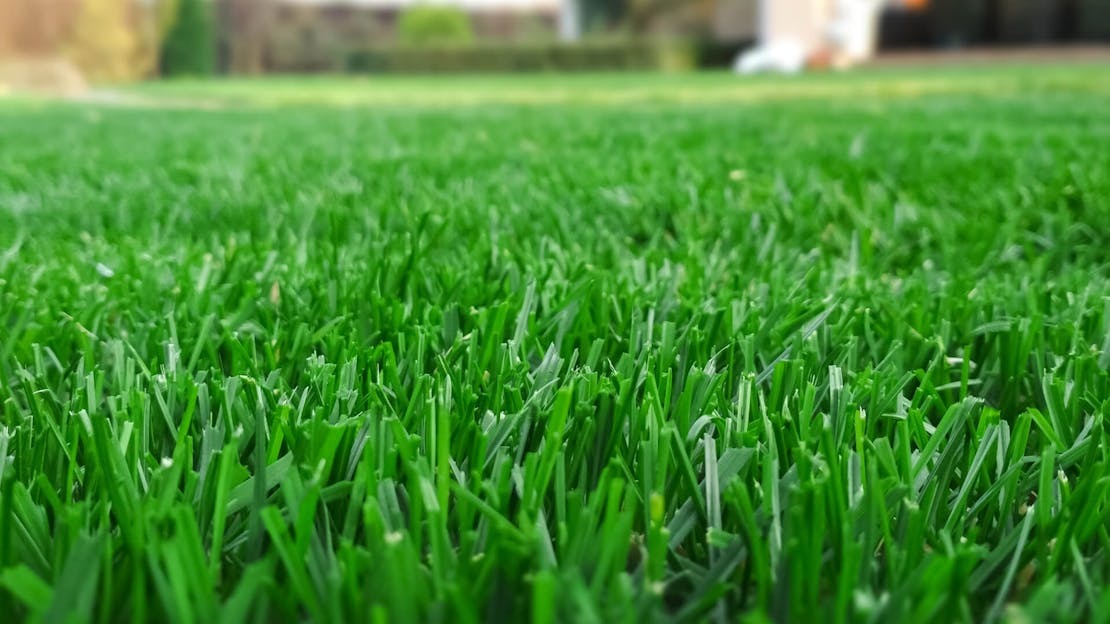
Mowing for a Dense Lawn
Most people mow their lawns too close. This causes thinning, weed and moss invasion, disease and premature drying
Cutting the lawn is the most time consuming part of lawn care so it seems sensible to do it correctly. The effort will reward you with a better looking lawn and you may well save time and money in lawn fertiliser, weed killer and grass seed for repairs.
It’s boring but…
Grass unlike you or me doesn’t eat. We eat and digest food whereas a plant makes its own; I’m sure you’ve heard of photosynthesis.
Photosynthesis is more akin to how a factory works – raw materials go in one end (water & fertiliser), energy is used (in this case sunlight instead of gas or electricity) and food is produced (carbohydrates and proteins not pizzas).
This food is then either stored for hard times just as we store fat, or used to grow leaves and roots; equivalent to muscle and bone.
A Solar Factory
The leaves of the grass ‘trap’ sunlight to power this grass plant ‘factory’. This can be likened to putting solar panels on your roof to make hot water. To get the maximum amount of hot water you want big panels facing south and lots of sun! If you put a panel in the shade or on the north side of the house or if you use a small panel you’ll not get so much hot water.
It’s not a lot different for grass. Grass that is say 2″ long has quite a bigger leaf area. Now give the grass lots of sunshine and the grass will manufacture plenty of food making the lawn green and healthy.
Reduce the amount of sun going into the plant by putting your lawn in the shade or shaving it off at the knees is a bit like shading or ripping out a solar panel – less sunlight is trapped meaning less food for the plant (or less hot water for a bath).
When you reduce the amount of sun the grass gets whether by shade or ‘close’ mowing, the plants protection systems kick in. It starts growing leaves faster so that it can replace the leaf you cut off or make up for being in the shade. This means the closer you mow the faster the grass grows!
The grass plants future survival depends on it manufacturing food, which it can’t do without an adequate amount of leaf. Imagine if a gale blew away your solar panels in the middle of winter and therefore cut off your heating. If you don’t replace them you’ll freeze to death. Grass leaves are just as important to a grass plant! Are you starting to get the picture?
The Consequences of Close Mowing
The upshot of all this ‘close’ mowing is that all the plants food reserves get used up replacing leaves cut after cut. This is at the expense of fighting off disease and maintaining good colour.
In addition, cutting grass short reduces rooting depth, which in turn reduces the water the plant gets. This can cause stress, weakness and even grass death during extended dry spells.
The Moral of the Story
What we should learn from this is that the leaves of the grass are vital organs and they need to be treated with respect. Anything that reduces the size or quality of the leaf affects the health of the plant.
Therefore grass mowing should be sympathetic and a compromise between getting the superb-looking lawn you want and what the grass plant needs to survive and remain healthy.
If you cut the grass below ¾” and your lawn is thin or patchy or full of weeds or moss the chances are the lawn mower is the cause of many of your problems. However, cutting the grass the right way, at the right time and at the right height causes the grass little harm and with a little help from some fertiliser produces a fantastic looking healthy, dense green lawn.
You may wonder why a bowling green or golf green looks so good when it is kept at perhaps 6mm or 1/4”. This is because of the grass type used (mainly bents) and the maintenance routine employed enable the grass to survive at this height. This often means mowing daily plus a whole host of other maintenance jobs. As a rule the closer you mow the more work is involved!
Now that you have a little more respect for the millions of individual plants that make up your lawn perhaps you can also appreciate that a sharp mower blade and a quality cut are also highly desirable.
When you cut the grass it ‘bleeds’ just like you do when cut. Fortunately it is sap not blood but it is just as vital. As you know, a jagged cut is more painful and slower to heal than a clean cut. A jagged cut is also more prone to infection. It’s no different for the grass, so if you want to ensure your grass heals quickly after you’ve cut it, use a lawn mower with plenty of power and a sharp blade.